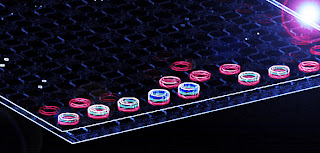A version of the quantum Hall effect (QHE) involving light rather than electrons has been created by physicists in the US. The team believes the demonstration could boost understanding of the QHE and perhaps lead to the development of better photonic circuits that use light to process information.
The QHE is a well-known phenomenon that occurs when a voltage is applied along a thin conducting sheet and a magnetic field is applied perpendicular to the sheet's surface. Throughout most of the sheet, the magnetic field makes conduction electrons travel in circular orbits that are quantized. At the edge of the sheet, however, the electrons cannot travel in circles because they would have to leave the sheet and re-enter it. Instead, these electrons hop along the edge in repeated semicircles. Crucially, they will travel along the edge regardless of its shape, following any dents or bulges.
These "topologically protected" paths and other aspects of the QHE have proven to be a rich seam of physics research that has led to two Nobel prizes. However, certain key predictions of QHE theory, such as the presence of bound electron states called anyons, remain unproven. This is because QHE experiments require pure samples, cryogenic temperatures and an ultra-high magnetic field – making measurements difficult to do.
Physics World: Quantum Hall effect created using light

Comments